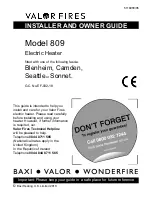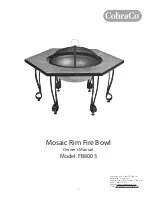
cuiheat.com
126345-01D
9
Determining Minimum Mantel Clearance
If you meet minimum clearance between mantel shelf and top of
fireplace opening, a hood is not required (see Figure 6).
NOTICE: Surface temperatures of adjacent walls and
mantels become hot during operation. Walls and
mantels above the firebox may become hot to the
touch. If installed properly, these temperatures meet
the requirement of the national product standard. Fol-
low all minimum clearances shown in this manual.
NOTICE: If your installation does not meet the minimum
clearances shown, you must do one of the following:
• operate the logs only with the flue damper open
• raise the mantel to an acceptable height
• remove the mantel
FLOOR CLEARANCES
The fireplace's required clearances to combustibles must be main-
tained. Consult your fireplace manufacturer's installation instructions
for minimum clearances. If permitted by the fireplace installation
instructions, combustible material may be installed up to the bottom
edge of the fireplace face (see figure 8).
Minimum
Noncombustible
Material
Minimum Non-
Combustible
Material Height
Distances to
Underside of
Mantel
Top of
Fireplace
Opening
Underside of
Mantel Shelf
Mantel Shelf
12"
(A)
18" 20" 22" 24"
2 ½"
6"
8"
10"
Figure 6 - Minimum Mantel Clearances Without Using Hood
INSTALLATION
Continued
Minimum clearance requirements include any projections such as
shelves, window sills, mantels, etc. above the appliance.
NOTE: To avoid heat-related finish damage, we recommend the use
of high temperature paint (rated 175° F or higher) on the underside
of the mantel.
Determining Minimum Mantel Clearance When Using a Hood
If minimum clearances in Figure 6, are not met, you must have a
hood. When using a hood there are still certain minimum mantel
clearances required. Follow minimum clearances shown in Figure 7
when using hood.
Figure 7 - Minimum Mantel Clearances When Using Hood
Minimum
Noncombustible
Material
8"
Min.
12" 15" 18" 20"
2½"
6"
8"
10"
12"
Distances to
Underside of
Mantel
Hood
(GA6050 or
GA6053)
Top of
Fireplace
Opening
Underside
of Mantel
Shelf
Mantel Shelf
Combustible
Material
Figure 8 - Minimum Fireplace Clearances If Installed at Floor
Level
INSTALLING DAMPER CLAMP ACCESSORY FOR VENTED
OPERATION
NOTE: When used as a vented heater, appliance must be installed only
in a solid-fuel burning fireplace with a working flue and constructed
of noncombustible material.
For Massachusetts Residents Only:
Installation of this vented gas
log set in the Commonwealth of Massachusetts requires the damper
be permanently removed or welded in the fully open position.
If your heater is a manually-controlled model, you may use this heater
as a vented product. There are three reasons for operating your heater
in the vented mode.
1. The fireplace does not meet the clearance to combustibles require-
ments for vent-free operation.
2. State or local codes do not permit vent-free operation.
3. You prefer vented operation.
If reasons number 1 or 2 apply to you, you must permanently open
chimney flue damper. You must install the damper clamp accessory
(to order, see Accessories, Page 31). This will ensure vented operation
(see Figure 9, page 10). The damper clamp will keep damper open.
Installation instructions are included with clamp accessory.










































